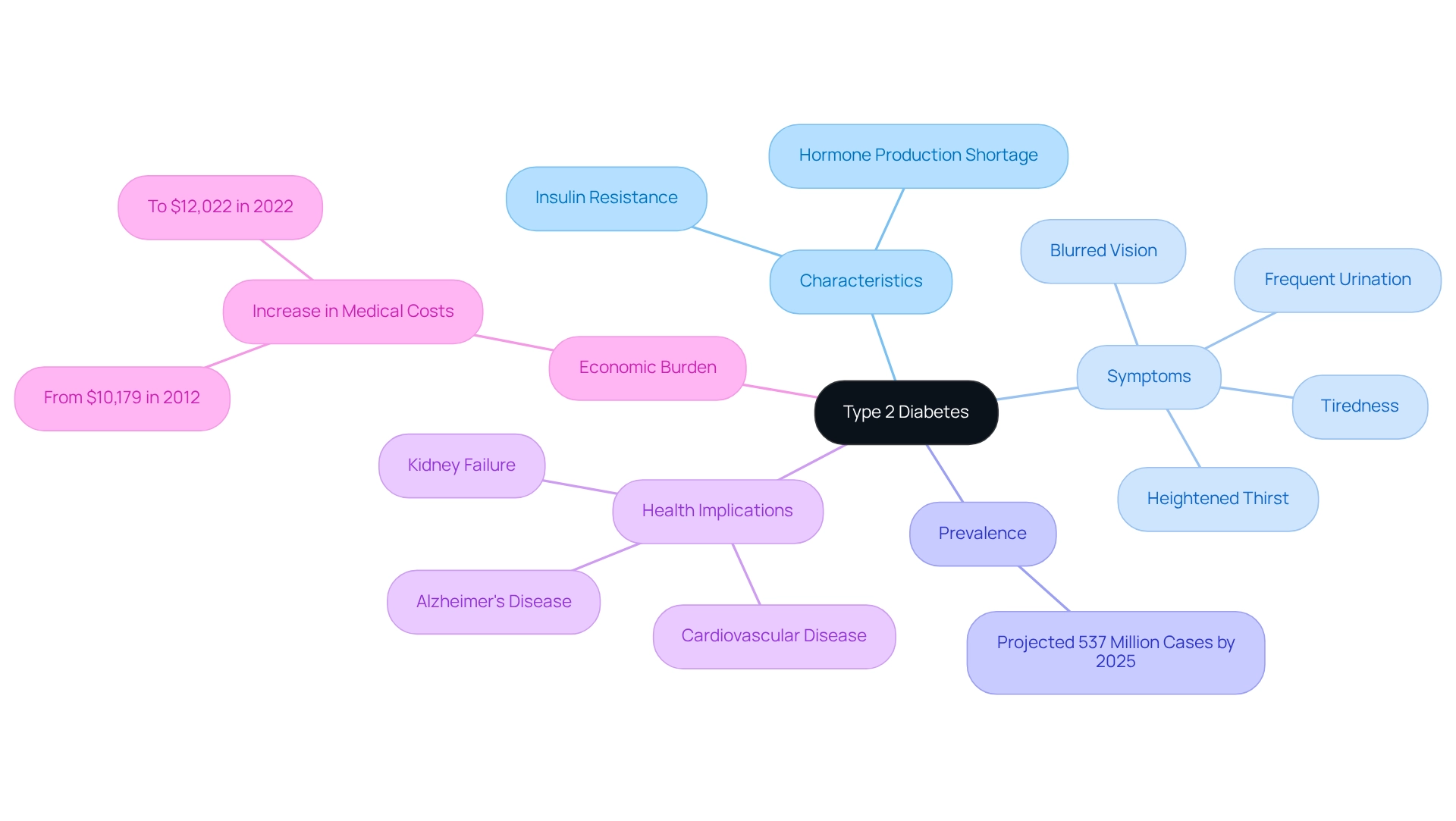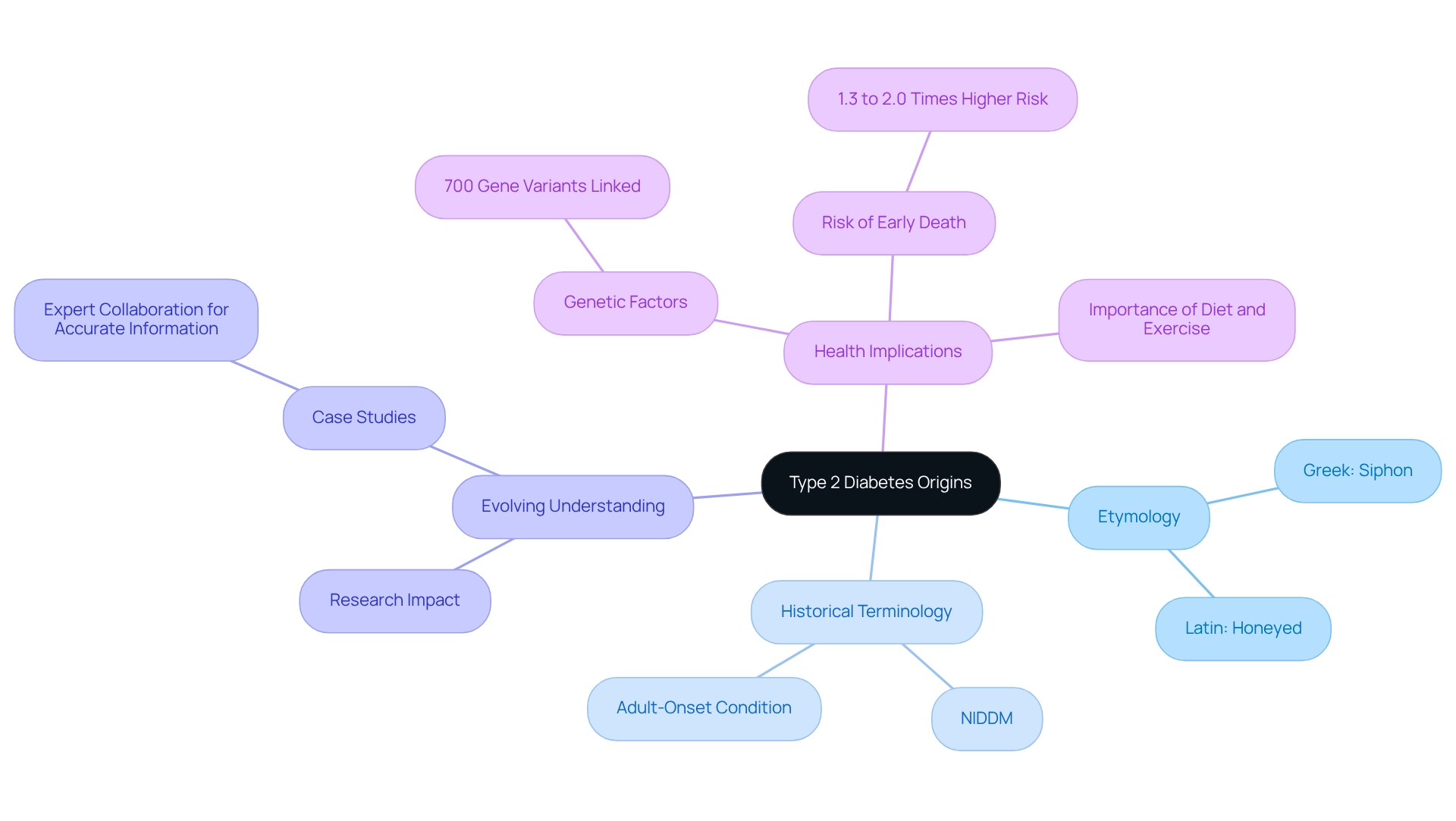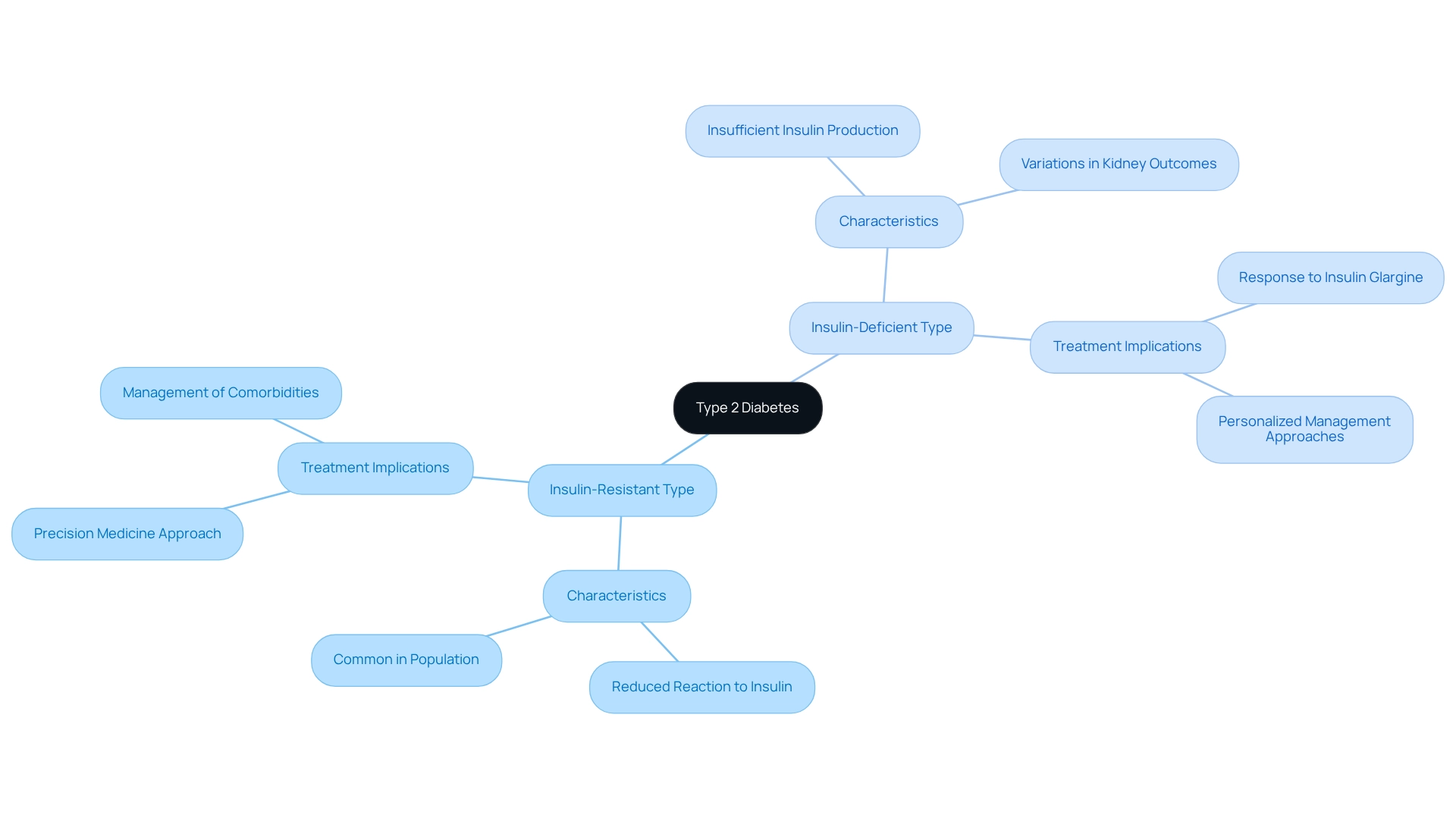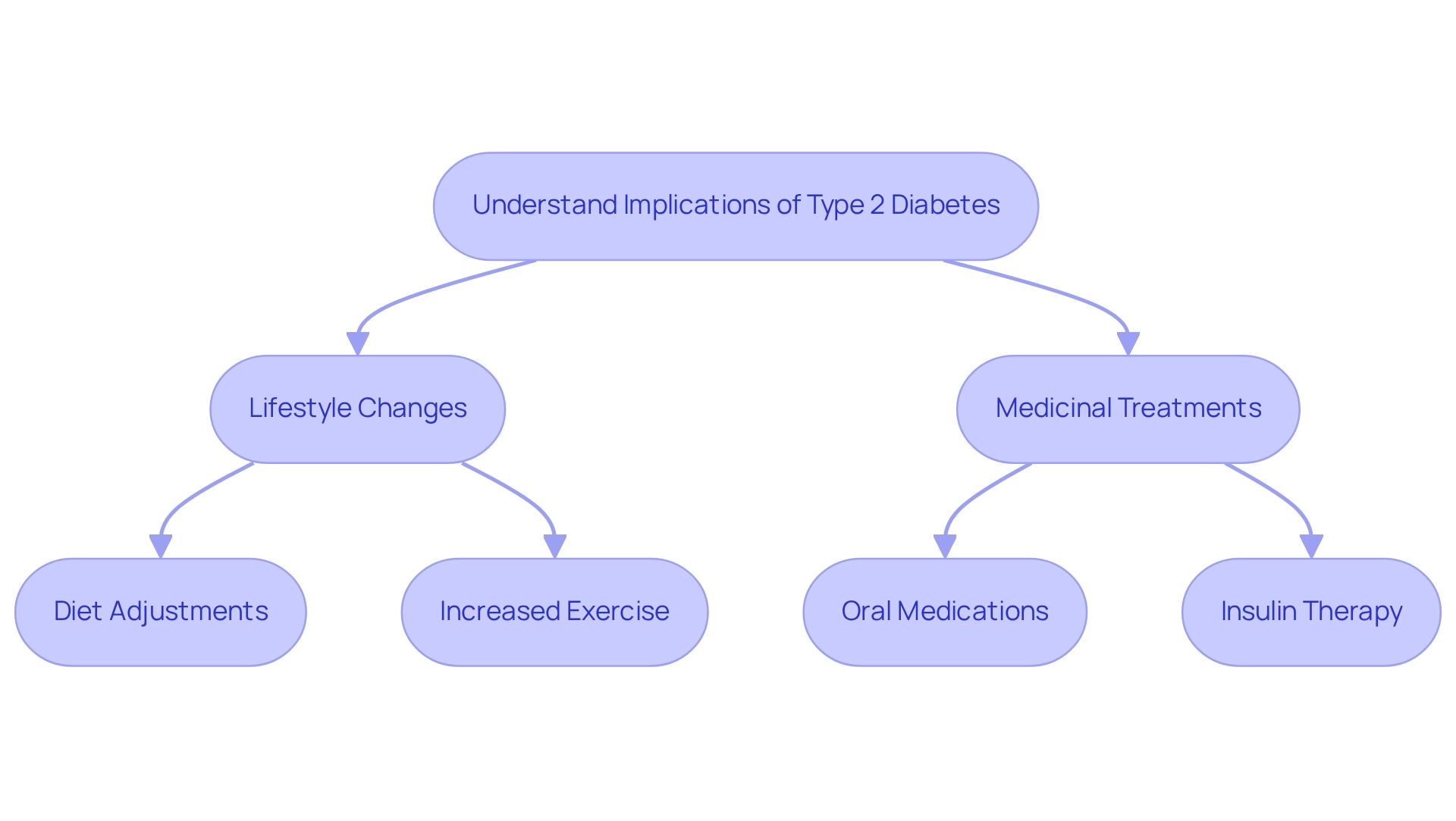Overview
The article titled "Understanding the Type 2 Diabetes Name: Origins and Implications" explores the historical background and significance of the term "type 2 diabetes." This name reflects not only the chronic nature of the condition but also highlights the importance of lifestyle modifications. It's understandable to feel overwhelmed by this diagnosis, but understanding this terminology can truly enhance your management strategies.
By grasping the implications of the term, individuals affected by the disease can improve their health outcomes. Remember, you’re not alone in this journey. We are here to support you every step of the way. Together, we can navigate the complexities of type 2 diabetes and find effective ways to manage it.
Introduction
In a world where chronic diseases are increasingly prevalent, Type 2 Diabetes (T2D) emerges as a significant public health challenge, impacting millions of lives around the globe. This complex metabolic disorder, marked by insulin resistance and elevated blood glucose levels, affects not only individual health but also has profound implications for healthcare systems and economies. It's understandable to feel overwhelmed by these statistics, especially with projections suggesting that the number of people living with diabetes will reach 537 million by 2025.
Understanding the nuances of T2D—from its origins and classifications to effective management strategies—is crucial for both healthcare providers and patients. As you navigate this multifaceted disease, remember that tailored interventions and lifestyle modifications can make a real difference. You're not alone in this journey; comprehensive education and support are vital steps toward better health. We are here to support you every step of the way.
Define Type 2 Diabetes: Key Characteristics and Significance
This chronic metabolic condition, commonly referred to by its type 2 diabetes name, is characterized by resistance to a hormone and a relative shortage in its production, leading to increased blood glucose levels. Unlike Type 1 Diabetes, where insulin production is absent, individuals with T2D can produce insulin, but their bodies do not utilize it effectively. Key symptoms include heightened thirst, frequent urination, tiredness, and blurred vision. These symptoms can significantly impact daily life and overall health, and it's understandable to feel overwhelmed by them, particularly given that the type 2 diabetes name accounts for about 90-95% of all cases of this condition worldwide. Current statistics indicate that as of 2025, the global prevalence is projected to reach 537 million individuals, with the type 2 diabetes name being the predominant form. This condition is not only common but also linked to serious health issues, such as cardiovascular disease, kidney failure, and neuropathy. Recognizing these connections emphasizes the importance of type 2 diabetes name in healthcare. Recent studies highlight the increasing awareness of the complexities of type 2 diabetes name, especially regarding hormone resistance and management strategies. For instance, the growing recognition of a link between Alzheimer’s disease and insulin resistance in the brain demonstrates the interrelation of this illness with other health issues. This emerging understanding can enhance preventive care and support for individuals at risk. Remember, you're not alone in this journey; there are resources available to help you navigate these challenges.
The economic burden of T2D is substantial, with excess medical costs per person rising from $10,179 in 2012 to $12,022 in 2022. This financial strain underscores the need for effective management and prevention strategies. By understanding the key characteristics and implications of the type 2 diabetes name, individuals and healthcare providers can work together to improve health outcomes and quality of life for those affected. We are here to support you every step of the way, encouraging you to seek the help and resources that can make a difference.

Trace the Origins of the Term 'Type 2 Diabetes'
The term 'diabetes' comes from the Greek word 'siphon,' reflecting the frequent urination that often accompanies this condition. When we add the Latin word 'mellitus,' meaning 'honeyed,' we see that 'diabetes mellitus' refers to the sweet-smelling urine that can be present in those affected. This terminology has evolved over time, particularly in the early 20th century when the type 2 diabetes name was initially referred to as 'non-insulin-dependent mellitus' (NIDDM) or 'adult-onset condition.' It's important to recognize that diabetes can manifest at any age, not just in adults.
As medical research has progressed, our understanding of diabetes has deepened, leading to changes in how we categorize this condition. Historical case studies illustrate this evolution, showing how our growing knowledge has shaped our approach to diabetes management. Experts emphasize that this evolution in terminology is crucial; it enhances awareness and understanding, empowering individuals to take charge of their health.
For those who have recently been diagnosed, understanding the origins of diabetes can provide valuable context for your management journey. Remember, you're not alone in this journey. Utilizing resources like T2DSolutions can offer essential support and education as you navigate this path. We are here to support you every step of the way.

Explore Classifications: Type 2 Diabetes and Its Variants
Understanding Condition 2 associated with high blood sugar can be overwhelming, but it’s important to know that you’re not alone in this journey. This condition is categorized based on clinical presentation and underlying mechanisms, with significant variants including insulin-resistant type 2 diabetes name and insulin-deficient type 2 diabetes name. The insulin-resistant form of diabetes occurs when the body has a reduced reaction to the hormone. In contrast, hormone deficiency arises when the pancreas does not produce enough insulin.
Recent studies, such as the 'Validation of Classification into Five Subgroups,' have emphasized unique subtypes of the second form of diabetes, which may respond differently to treatment. This classification highlights the importance of precision medicine in predicting how individuals will react to various treatments and manage comorbidities. It's understandable to feel uncertain about how these classifications affect you.
Significantly, results from the ORIGIN trial data demonstrated considerable variations in kidney outcomes and glycemic reactions to glargine among these subtypes. Comprehending these classifications is crucial for developing personalized management approaches that cater to your specific needs. As insulin resistance remains a common feature among individuals with the type 2 diabetes name, it impacts a substantial segment of the population.
As noted in Nature Communications, exploring these subtypes is vital for advancing diabetes care. Remember, we are here to support you every step of the way as you navigate your health journey. If you have questions or need resources, don’t hesitate to reach out for help.

Understand the Implications of the Name 'Type 2 Diabetes' for Management
The type 2 diabetes name carries significant implications for management, emphasizing the importance of lifestyle changes—especially in diet and exercise—to effectively control blood sugar levels. This classification reflects not only the chronic nature of the condition but also the necessity for ongoing monitoring and management to prevent complications. It's understandable to feel overwhelmed, but research shows that extensive lifestyle modifications can greatly reduce the likelihood of developing the type 2 diabetes name in at-risk groups. Timely adjustments can make a real difference.
Healthcare professionals recognize that this classification informs them about potential medicinal treatments, including oral medications and insulin therapy, tailored to each patient's unique situation. Current guidelines advocate for a holistic approach, where lifestyle modifications serve as foundational elements in diabetes management.
Real-world examples illustrate the effectiveness of these strategies. For instance, the Eriksson and Lindgarde study, which involved 181 Swedish men, demonstrated that a structured approach focusing on dietary changes and increased physical activity could prevent the onset of Type 2 Diabetes. Such findings underscore the critical role of lifestyle adjustments in managing this condition, highlighting that understanding the implications of 'type 2 diabetes name' is essential for both patients and healthcare providers. It enables the creation of effective management plans that enhance quality of life and significantly reduce the risk of complications associated with the disease. You're not alone in this journey. As T2DSolutions launches as a new resource hub, it aims to provide valuable educational materials and community support to assist individuals in navigating their diabetes management journey. We are here to support you every step of the way.

Conclusion
Understanding the complexities of Type 2 Diabetes (T2D) is vital for recognizing its characteristics, origins, and management strategies. As a chronic metabolic disorder, T2D not only impacts individual health but also presents significant challenges for healthcare systems and economies worldwide. With alarming projections of increasing prevalence, it's crucial to acknowledge the implications of insulin resistance, the need for tailored interventions, and the potential for severe complications if left unmanaged.
The evolution of the term 'Type 2 Diabetes' highlights a deeper understanding of this condition, showing that it can manifest at any age and necessitates a comprehensive management approach. By identifying the different subtypes of T2D, precision medicine can play a key role in treatment, ensuring that individuals receive the most effective interventions based on their unique circumstances.
Ultimately, making proactive lifestyle modifications and engaging in ongoing education are essential for effective diabetes management. By embracing these strategies, you can significantly improve your quality of life and reduce the risk of complications associated with T2D. Resources like T2DSolutions are invaluable in providing the necessary support and knowledge to empower you on your journey toward better health. Remember, the path to managing Type 2 Diabetes may be challenging, but with the right tools and understanding, you can navigate this journey successfully. You're not alone in this journey; we are here to support you every step of the way.
Frequently Asked Questions
What is type 2 diabetes (T2D)?
Type 2 diabetes is a chronic metabolic condition characterized by resistance to insulin and a relative shortage in its production, leading to increased blood glucose levels. Unlike Type 1 diabetes, individuals with T2D can produce insulin, but their bodies do not use it effectively.
What are the key symptoms of type 2 diabetes?
Key symptoms of type 2 diabetes include heightened thirst, frequent urination, tiredness, and blurred vision. These symptoms can significantly impact daily life and overall health.
How prevalent is type 2 diabetes worldwide?
Type 2 diabetes accounts for about 90-95% of all diabetes cases globally. As of 2025, the global prevalence is projected to reach 537 million individuals.
What serious health issues are linked to type 2 diabetes?
Type 2 diabetes is linked to serious health issues such as cardiovascular disease, kidney failure, and neuropathy.
How does type 2 diabetes relate to other health conditions?
Recent studies have highlighted a link between Alzheimer’s disease and insulin resistance in the brain, demonstrating the interrelation of type 2 diabetes with other health issues.
What is the economic impact of type 2 diabetes?
The economic burden of type 2 diabetes is substantial, with excess medical costs per person rising from $10,179 in 2012 to $12,022 in 2022, emphasizing the need for effective management and prevention strategies.
What resources are available for individuals with type 2 diabetes?
There are various resources available to help individuals navigate the challenges of type 2 diabetes, including support from healthcare providers and educational materials.



